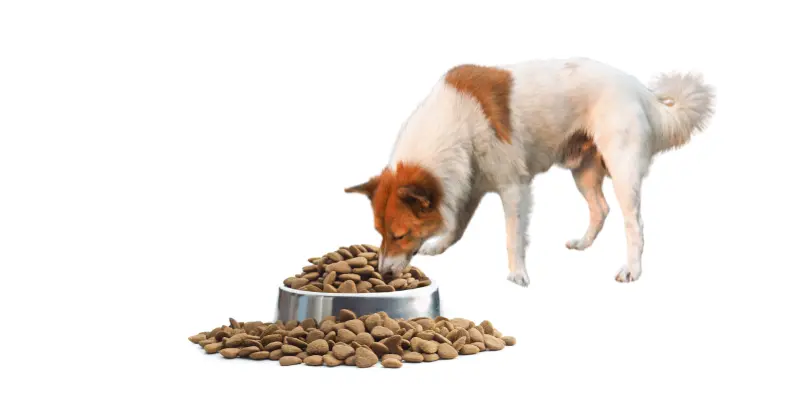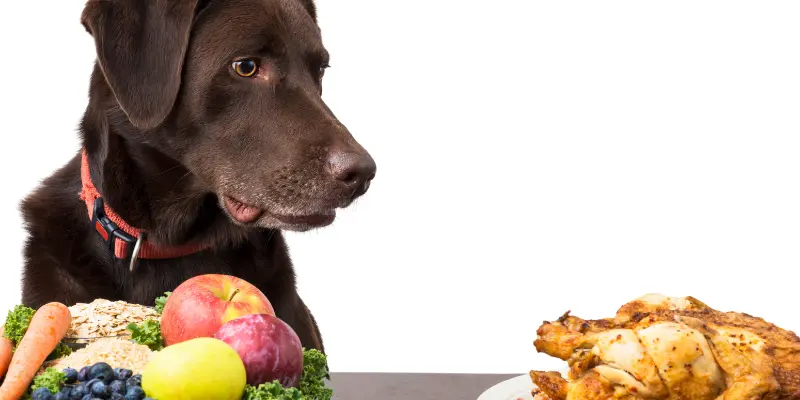Total Dog Food Route – The Best Guide For Healthy Dog Nutrition
Published: 20 May 2025
Total dog food route offers a comprehensive guide to choosing the best nutrition for your dog, ensuring they stay healthy and happy throughout their life. Feeding your dog the right food is one of the most important things you can do to keep them happy and healthy.
Table of Contents
Types of Dog Food Explained
Choosing the right type of dog food can be overwhelming, but understanding the different options available will help you make the best choice for your pets health.

1. Dry Food (Kibble)
- Easy to store and serve.
- Helps keep teeth clean.
- Less expensive than other types.
- Make sure it has real meat and not too many fillers.
2. Wet Food (Canned Food)
- Soft and tasty for most dogs.
- Good for dogs who don’t drink much water.
- Can be more expensive.
- Needs to be used quickly after opening.
3. Raw Food
- Includes raw meat, bones, fruits, and vegetables.
- Some dog owners like it because it’s natural.
- Must be handled safely to avoid germs.
- Talk to a vet before feeding raw meals.
4. Homemade Food
- You can cook fresh meals for your dog at home.
- You control what goes into the food.
- Needs the right mix of nutrients.
- Ask a vet to help plan a healthy recipe.
5. Freeze-Dried or Dehydrated Food
- Real food that is dried to last longer.
- Add water before feeding.
- Healthier than kibble in many cases.
- Can be costly.
6. Prescription Food
- Made for dogs with health problems.
- Only given if a vet says it’s needed.
- Helps with kidney, liver, or allergy issues.
- Not for all dogs, only for special needs.
Transitioning Between Foods
“Transitioning between different dog foods requires care and patience to ensure your dog’s digestive system adjusts smoothly without causing discomfort.”
1. Why Transition Slowly?
- Changing food too fast can upset your dog’s stomach.
- Slow changes help your dog adjust without getting sick.
2. When to Change Dog Food
- Your dog is growing (puppy to adult).
- Health issues or allergies show up.
- You want better ingredients or a new brand.
- Vet recommends a new diet.
3. 7-Day Transition Plan
- Day 1–2: 75% old food + 25% new food
- Day 3–4: 50% old food + 50% new food
- Day 5–6: 25% old food + 75% new food
- Day 7: 100% new food
4. Watch Your Dog Closely
- Check for loose stool or vomiting.
- See if your dog likes the new taste.
- Look for signs of allergy (itching, red skin).
5. Tips for a Smooth Transition
- Keep mealtimes the same every day.
- Add a little warm water if needed to improve taste.
- Don’t mix treats during the switch keep it simple.
6. Talk to Your Vet
- If your dog isn’t eating or seems sick, call your vet.
- Some dogs need a longer transition time.
Homemade Dog Food Recipes
“Preparing homemade dog food can be a healthy and rewarding way to ensure your pet gets the best nutrition, with the Total Dog Food Route guiding you every step.”
1. Why Make Food at Home?
- You know what’s in your dog’s bowl.
- No hidden chemicals or fake ingredients.
- Fresh and safe meals made with love.
2. Important Ingredients to Include
- Protein: Chicken, beef, turkey, or eggs
- Carbs: Rice, oats, or sweet potatoes
- Vegetables: Carrots, peas, spinach (cooked and chopped)
- Healthy Fats: Olive oil, fish oil, or a bit of coconut oil
- Calcium: Crushed eggshell powder (very small amount)
3. Simple Chicken & Rice Recipe
- 1 cup boiled chicken (no bones)
- ½ cup cooked rice
- ¼ cup steamed carrots and peas
- 1 tsp olive oil
→ Mix well and cool before serving.
4. Beef & Sweet Potato Bowl
- 1 cup lean ground beef (cooked well)
- ½ cup boiled sweet potato (mashed)
- ¼ cup green beans (chopped, cooked)
- A pinch of crushed eggshell for calcium
→ Stir together and serve at room temperature.
5. Egg and Veggie Mix for Light Meals
- 2 boiled eggs (chopped)
- ½ cup cooked oats
- ¼ cup spinach and pumpkin (steamed and mashed)
→ Add a few drops of fish oil for a shiny coat.
6. Things to Avoid
- No onions, garlic, grapes, chocolate, or salty foods.
- Don’t use spices like chili, pepper, or masalas.
- No raw dough or sugary treats.
7. Tips for Safe Cooking
- Cook meat fully no raw pieces.
- Store in the fridge for up to 3 days.
- Make small batches to keep it fresh.
- Clean bowls and hands before and after cooking.
8. Ask Your Vet
- Check if your dog needs extra vitamins.
- Every dog is different vet advice makes it safer.
Sustainable And Ethical Dog Food Choices
Choosing dog food that is good for the planet and kind to animals is called making sustainable and ethical choices. These foods are made without hurting the earth or treating animals badly. Look for brands that use natural ingredients, avoid factory farming, and care about clean energy and recycling.

Some companies also use insect protein or plant-based recipes, which are better for the environment. Buying local or small-batch dog food also helps reduce pollution. This way, you care not only for your dog but also for the world they live in.
Advantages and Disadvantages of Total Dog Food Route
“Before choosing the right food for your dog, it’s important to weigh the advantages and disadvantages. Here’s a quick overview to help you decide.”
| Pros |
|---|
|
| Cons |
|---|
|
FAQs About Total Dog Food Route
“Got questions about feeding your dog? Check out these frequently asked questions to get clear answers and ensure you’re making the best food choices for your pet.”
The Total Dog Food Route is a step-by-step guide to feeding your dog the right food at every stage of their life. It helps you choose the best food options, whether dry, wet, raw, or homemade, to ensure your dog’s health and happiness.
Choose food based on your dog’s age, breed, size, and health condition. Consult a vet to make sure you’re meeting their specific nutritional needs.
Yes, you can mix kibble with wet food or homemade meals, but it’s important to transition slowly to avoid stomach issues. Always maintain a balanced diet.
Gradually mix the new food with the old food over the course of 7-10 days to help your dog adjust without upsetting their stomach.
Homemade food can be healthy if you include the right ingredients like protein, veggies, and healthy fats. However, make sure to consult your vet to avoid nutritional imbalances.
Raw food diets can be healthy for some dogs, but they require proper handling and preparation. Always consult your vet before starting a raw food diet.
It depends on your dog’s age and size. Puppies may need more frequent meals, while adult dogs typically eat twice a day.
Conclusion
Feeding your dog the right food is essential for their health and well-being. The Total Dog Food Route offers a clear, step-by-step guide to help you make the best food choices for your dog, no matter their age or needs. Whether you choose dry kibble, wet food, or even homemade meals, it’s important to transition carefully, avoid common mistakes, and consult your vet when needed. With the right food, your dog will live a long, healthy, and happy life by your side.
Article by Pets Osrs

- Be Respectful
- Stay Relevant
- Stay Positive
- True Feedback
- Encourage Discussion
- Avoid Spamming
- No Fake News
- Don't Copy-Paste
- No Personal Attacks

- Be Respectful
- Stay Relevant
- Stay Positive
- True Feedback
- Encourage Discussion
- Avoid Spamming
- No Fake News
- Don't Copy-Paste
- No Personal Attacks





